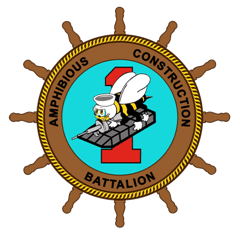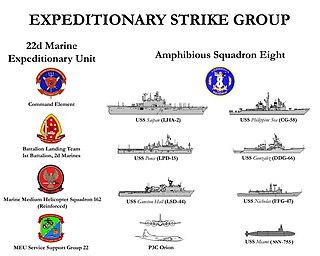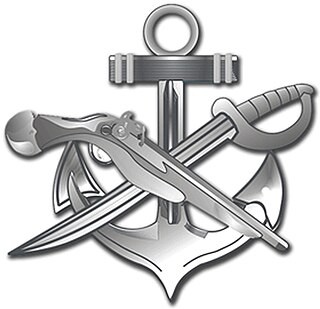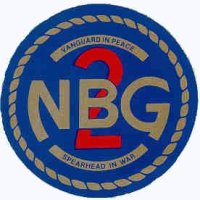
The Tarawa class is a ship class of Landing Helicopter Assault (LHA) type amphibious assault ships operated by the United States Navy (USN). Five ships were built by Ingalls Shipbuilding between 1971 and 1980; another four ships were planned, but later canceled; instead they were joined by the Wasp-class amphibious assault ships.

The Netherlands Marine Corps is the elite naval infantry corps of the Royal Netherlands Navy, one of the four Armed Forces of the Kingdom of the Netherlands. The marines trace their origins to the establishment of the Regiment de Marine on 10 December 1665, by the then grand pensionary of the Dutch Republic, Johan de Witt and famous Admiral Michiel de Ruyter. It is the second-oldest still-active marine corps in the world.

The United States Naval Special Warfare Command (USNSWC), also known as, is the naval component of United States Special Operations Command, the unified command responsible for overseeing and conducting the nation's special operations and missions.

In the Vietnam War, the Mobile Riverine Force (MRF) (after May 1967), initially designated Mekong Delta Mobile Afloat Force, and later the Riverines, were a joint US Army and US Navy force that comprised a substantial part of the brown-water navy. It was modeled after lessons learned by the French experience in the First Indochina War of Dinassaut and had the task of both transport (of soldiers and equipment) and combat. The primary land base was at Đồng Tâm Base Camp, with a floating base which operated in the major rivers of the Mekong Delta. Soldiers and sailors went out in river boats from the floating base to assault the Viet Cong. During part of the 1968-69 period, there were two such mobile bases operating in different parts of the Delta, Mobile Riverine Groups Alpha and Bravo. The MRF played a key role in the Tet Offensive.

USNS Sacagawea (T-AKE-2), a Lewis and Clark-class dry cargo ship, is the third ship operated by the United States Navy to be named for Sacagawea, the Shoshone woman who acted as guide and interpreter for the Lewis and Clark Expedition, and one of the few United States Navy ships named for women.
PHIBRON is a United States Navy abbreviation for Amphibious Squadron. It is a tactical and administrative organization composed of amphibious assault shipping to transport troops and their equipment for an amphibious assault operation.

A Landing Craft Utility (LCU) is a type of boat used by amphibious forces to transport equipment and troops to the shore. They are capable of transporting tracked or wheeled vehicles and troops from amphibious assault ships to beachheads or piers.

The landing craft mechanized (LCM) is a landing craft designed for carrying vehicles. They came to prominence during the Second World War when they were used to land troops or tanks during Allied amphibious assaults.

Naval Amphibious Base Coronado is a US naval installation located across the bay from San Diego, California. The base, situated on the Silver Strand, between San Diego Bay and the Pacific Ocean, is a major Navy shore command, supporting over 30 tenant commands, and is the West Coast focal point for special and expeditionary warfare training and operations. The on‑base population is 5,000 military personnel and 7,000 students and reservists. The base is one of the eight components of Naval Base Coronado (NBC).

The Navy Expeditionary Combat Command (NECC) is an echelon III command of the United States Navy, which serves as the single functional command to centrally manage current and future readiness, resources, manning, training and equipping of the United States Navy's 21,000 expeditionary forces who are currently serving in every theater of operation. The NECC was established in January 2006. NECC is a subordinate command of the Navy's Fleet Forces Command.

Amphibious Construction Battalion ONE is an amphibious construction battalion in the United States Navy based in Coronado, California. Amphibious Construction Battalion TWO is its sister unit based in Little Creek, Virginia.

In the United States Navy, the expeditionary strike group (ESG) is a coordinated group of surface ships, aircraft, submarines, and other naval assets. In contrast to carrier strike groups (CSGs), which emphasize air power and are led by a supercarrier, ESGs are strongly suited for amphibious warfare and are led by an amphibious assault ship. The ESG concept was introduced in the early 1990s, based on the Naval Expeditionary Task Force. The U.S. Navy fields nine expeditionary strike groups.

The Special Warfare Combat Crewmen is a United States Naval Special Warfare Command team that operates and maintains small craft for special operations missions, particularly those in support of the U.S. Navy SEALs.

A Maritime Special Purpose Force (MSPF) is a United States Marine Corps specialized sub-unit of a Marine expeditionary unit. A MSPF is deployed to give the commanders low profile, two-platoon surgical emplacement in the accessible littoral regions. The MSPF provides the enhanced operational capability and precision skills to complement, enable, and execute selected conventional, maritime special operations. They can also perform operations not resident in traditional amphibious raid companies.

The Khmer National Navy was the naval component of the Khmer National Armed Forces (FANK), the official military of the Khmer Republic during the Cambodian Civil War between 1970 and 1975.

The Maritime Prepositioning Force (MPF) Utility Boat (MPFUB) is a commercially designed utility craft used primarily to move personnel and light equipment during MPF offload operations. The 41 foot long, high-speed landing craft are replacing the Navy’s existing LCM-8 craft as part of the United States Navy's Improved Navy Lighterage System (INLS) in support of pre-positioned Marine Amphibious assault missions. Additional missions include supporting waterborne force protection, transportation of personnel and materials, medical evacuation, salvage, damage control, and repair operations.

Assault Craft Unit TWO (ACU-2) is an Atlantic Ocean Maritime Prepositioning Force in the United States Navy operated under Naval Beach Group Two out of Naval Amphibious Base Little Creek, Virginia. ACU-2's force consists of Landing Craft Utility boats (LCU), Landing Craft Mechanized, Mark 8 boats (LCM), and Maritime Prepositioning Force Utility Boats (MPFUB). The sister unit of ACU-2 is Assault Craft Unit 1 in Naval Amphibious Base Coronado.

Naval Beach Group One, (NBG-1) is a United States Navy amphibious unit based at Naval Amphibious Base Coronado in Coronado, California. Naval Beach Group Two is its sister unit based at Naval Amphibious Base Little Creek, Virginia.

Naval Beach Group Two, (NBG-2) is a United States Navy amphibious unit based at Naval Amphibious Base Little Creek, Virginia Beach, Virginia. Naval Beach Group One is its sister unit based in Naval Amphibious Base Coronado in Coronado, California.

Naval Support Activity Danang or NSA Danang was a United States Navy logistics support organization located in Danang, South Vietnam active from October 1965 to April 1972.




















